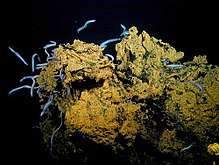Dysommina rugosa
Dysommina rugosa is an eel in the family Synaphobranchidae (cutthroat eels). It was described by Isaac Ginsburg in 1951.[2] It is a marine, deep water-dwelling eel which is known from the western Atlantic and eastern central Pacific Ocean. It dwells at a depth range of 260–775 metres, and is found off the continental slope. Males can reach a maximum total length of 37 centimetres.
| Dysommina rugosa | |
|---|---|
 | |
| "Eel City" | |
| Scientific classification | |
| Kingdom: | Animalia |
| Phylum: | Chordata |
| Class: | Actinopterygii |
| Order: | Anguilliformes |
| Family: | Synaphobranchidae |
| Genus: | Dysommina |
| Species: | D. rugosa |
| Binomial name | |
| Dysommina rugosa Ginsburg, 1951[1] | |
Description
D. rugosa is a fairly stout elongated cylindrical fish growing to a total length of about 350 mm (14 in). The snout is fleshy with a number of papillae and tapers towards the front, overhanging the lower jaw. There are two pairs of nostrils, one pair at the tip of the snout and the other pair between the eyes, which are large and circular and covered with skin. There are no premaxillary teeth and the maxillary and dentary teeth are tiny and arranged in a number of irregular rows. The roof of the mouth has four large, compound vomerine teeth. The gill openings are crescent-shaped and about the same size as the eyes. The origin of the dorsal fin is further back than the origin of the pectoral fins. The dorsal and anal fins are confluent with the small caudal fin. The ventral surface of this fish is darker than the head and dorsal surface, and the pectoral, dorsal and anal fins are pale[3] with yellowish-white edges.[4]
Distribution and habitat
The species occurs in the tropical western Atlantic Ocean, the Caribbean Sea and Gulf of Mexico as well as the eastern and central Pacific Ocean and Hawaii. It is a deepwater species found near the seabed on the continental slope at depths between 260 and 775 m (850 and 2,540 ft).[4]
Eel City
In 2005, during underwater exploration of the caldera of Vailulu'u volcano at a depth of about 700 m (2,300 ft) in the mid-Pacific, it was found that large numbers of eels were present in low-temperature hydrothermal vents at a locality the researchers dubbed "Eel City".[5] This area had pillow lava flows draped with yellowish microbial mats, and whenever the submersible touched down, previously hidden eels, since identified as Dysommina rugosa, swarmed into the water column. It is thought that the eels hide in crevices in the yellow mats for their own protection and feed on planktonic crustaceans drifting past.[5]
References
- Bailly, Nicolas (2008). "Dysommina rugosa Ginsburg, 1951". WoRMS. World Register of Marine Species. Retrieved 15 October 2017.
- Ginsburg, I., 1951 (30 Sept.) [ref. 1804] The eels of the northern Gulf Coast of the United States and some related species. Texas Journal of Science v. 3 (no. 3): 431–485.
- McEachran, John; Fechhelm, Janice D. (2013). Fishes of the Gulf of Mexico, Vol. 1: Myxiniformes to Gasterosteiformes. University of Texas Press. pp. 245–246. ISBN 978-0-292-75705-9.
- "Dysommina rugosa Ginsburg, 1951". FishBase. Retrieved 15 October 2017.
- Young, Craig (31 July 2005). "Eel City and the Moat of Death: An Active Volcano on the Samoan Hotspot". Ocean Explorer. NOAA. Retrieved 19 October 2017.